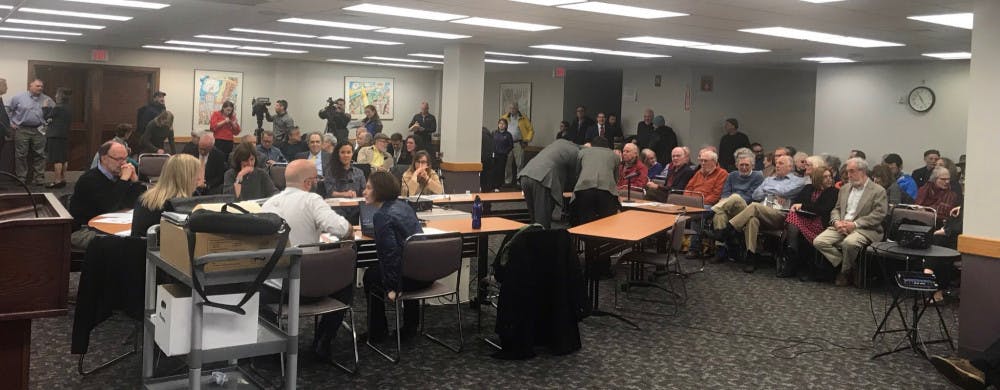The most recent design-concept application for Hope Point Tower, a proposed luxury apartment building, was denied in a unanimous advisory vote Monday by Providence’s Downtown Design Review Committee.
The developer of the project was seeking approval for zoning waivers that would allow the building to exceed the 100-foot height maximum by almost 500 feet.
Height has been a major obstacle for Hope Point Tower developers, who would like to make the building the tallest in the state. The hearing room at 444 Westminster St. was packed Monday evening with dozens of unhappy residents, who gladly received the DDRC recommendation to reject waivers vital to the completion of the project’s current design, including the proposed height.
If built, Hope Point Tower would sit on parcel 42 within former I-195 state highway land. Under special state legislation, the I-195 Commission will have final say on the tower’s design, making DDRC’s rejection of the waivers non-binding.
Following a presentation of the design from the building’s Chief Architect Gianni Ria, the staff report recommended the DDRC deny the design-concept application.
Chief among the report’s recommendations was a suggestion to reject a permit that was approved by the Providence City Council and the I-195 Commission, which would allow the tower to rise to 46 stories, despite the 100-foot height limit in the area, The Herald previously reported.
“A height of 556 feet and 46 stories … raises a serious concern that this building will never relate to adjacent structures. Staff does not recommend that this waiver be granted,” a council member read from the staff report. The statement was met by immediate applause from many in the room.
The report urged the DDRC to recommend the I-195 Redevelopment District Commission deny conceptual design approval altogether.
In addition to rejecting the height waiver, the DDRC recommended against the current design of a “podium” structure, which would include parking and sit below the residential portions of the building. “The building design is unsuccessful in its attempt to create a uniform transition between the upper tower and lower podium story,” according to the DDRC staff report.
After reading the report and before voting, 25 members of the public spoke at the meeting, representing organizations including the Providence City Council, Providence Preservation Society, neighborhood associations and construction companies, among others.
First to speak was City Councilman Seth Yurdin (Ward-1), who directed his statements to the DDRC : “The economic impact (of the tower), all the impacts that you were to take into consideration, lead to a denial. … I would urge you to follow the staff recommendation and not approve the request.”
Providence Preservation Director Rachel Robinson agreed with the report, adding that, “If and as this project moves forward, we’d like to support the recommendation for a traffic and shadow study.”
“Mr. Fane asked to deliver an iconic building for Providence,” said Sharon Steele, acting president for the Jewelry District Association. “We have one, Mr. Fane. It’s called the Superman Building. He asked to put Providence on the map. Roger Williams did it in 1636. So we’re here to say, ‘A day late and a dollar short. Please build it somewhere else. Thank you.’” The Superman Building is currently the tallest building in Rhode Island but lies vacant in Downtown Providence.
Chris Sarli ’22 also expressed opposition to Hope Point Tower. “Now I’m a lifelong Rhode Islander, and currently I’m a college student in Providence,” he said during the meeting. “Sometimes I wish I’d gone to school somewhere farther away, but that’s usually a fleeting thought because I remember how much I love this city. … The building and the policy that went into (the development of Hope Point Tower), it’s not the Providence I’ve known and it’s not the one I’d like to know.”
William Landry, a lawyer representing developers of Fane Tower LLC, said the report potentially went beyond its purview. “There were certain portions of the staff report tonight that potentially raised some legal interpretative issues as to when design review ceases to be design review” and becomes about more than the design itself, he said.
A meeting to present the recommendation to the I-195 Commission has not been scheduled, but the Commission will have the ultimate decision over the design’s fate.





